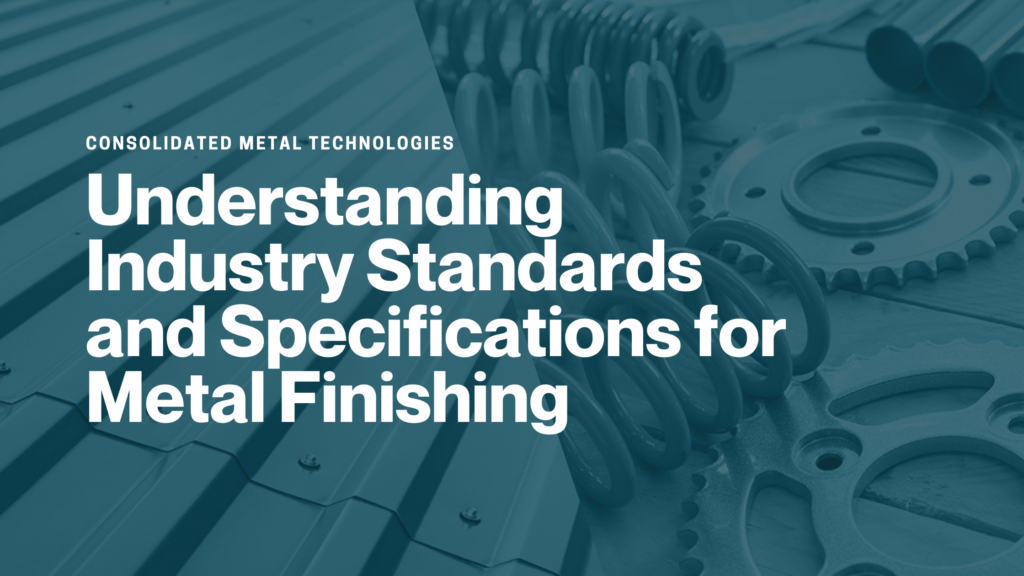
The metal finishing process is a critical step in enhancing metal components’ durability, appearance, and functionality across industries. Whether it’s ensuring corrosion resistance, achieving a specific aesthetic, or meeting regulatory requirements, adhering to metal finishing standards is essential for maintaining quality, consistency, and safety.
Consolidated Metal Technologies (CMT) exemplifies this commitment by adhering to various industry standards and specifications.
Why Industry Standards Matter
Industry standards in metal finishing ensure that processes and outcomes meet universally recognized benchmarks. These standards:
- Ensure quality: they provide detailed guidelines on material properties, performance expectations, and process execution, ensuring that the final product meets customer and industry expectations.
- Promote consistency: Standards create uniformity in production, guaranteeing that the same high-quality finish can be replicated across different batches or projects.
- Enhance safety: Adherence to specifications reduces risks during the manufacturing process and ensures compliance with environmental and safety regulations.
- Support cross-industry applications: Standards allow products to meet specific requirements in diverse industries, such as aerospace, automotive, and electronics.
Key Standards in Metal Finishing
CMT aligns its operations with an extensive list of specifications tailored to the unique demands of its clients. Below are some key processes and their corresponding standards:
Acid Etching
Standard: AMAT 0190-00144
Acid Etching prepares metal surfaces for further finishing, ensuring uniform texture and surface quality.
Anodizing
Standards: ASTM B580, MIL-A-8625
Anodizing enhances corrosion resistance and wear properties while providing an attractive finish for applications like aerospace components.
Bright Nickel Plating
Standards: ASTM AMS-2403, ASTM AMS-2423, QQ-N-290
Bright nickel plating creates a lustrous finish and provides exceptional wear and corrosion resistance, which is ideal for automotive and decorative applications.
Chemical Cleaning
Standards: AMAT 0250-09720, AMAT 0250-20000 App A & D, AMAT 0250-70351, AMAT 0250-31176
Chemical cleaning is a critical preparatory step that removes contaminants and ensures the cleanliness required for subsequent metal finishing operations.
Chromate Conversion Coating
Standards: ASTM B449, MIL-C-5541E, MIL-DTL-5541F
Commonly used for aluminum, chromate conversion coatings provide corrosion resistance and serve as a primer for paint or adhesives.
Electroless Nickel Plating
Standards: MIL-C-26074, MIL-DTL-32119, ASTM B733 Type V, SAE AMS-C-2404
Electroless nickel plating applies a uniform nickel-phosphorous coating, offering superior protection against corrosion and wear without needing an electrical current.
Passivation
Standard: AMS-2700, ASTM A380, ASTM A967, QQ-P-35
Passivation enhances stainless steel’s corrosion resistance by removing surface contaminants and creating a passive oxide layer. This process is vital for medical, aerospace, and food processing industries, where material purity is critical.
Powder Coating
Standard: Internal specification
Powder coating provides a durable, high-quality finish, offering environmental benefits by avoiding solvent-based paints.
Tin Plating
Standards: ASTM B545, MIL-T-10727
Tin plating is widely used in electronics and food-safe applications due to its excellent conductivity, corrosion resistance, and non-toxic properties.
Zinc Plating
Standards: ASTM B633, QQ-Z-325
Zinc plating offers excellent corrosion protection for steel components, which are commonly used in construction and industrial applications.
The Role of Certified Compliance
Rigorous quality controls and certified compliance back each metal finishing process at CMT. By leveraging industry standards, CMT ensures that every finish meets stringent performance and aesthetic requirements, supporting applications across industries like semiconductor manufacturing, aerospace, and more.
Partner with CMT for Excellence
When it comes to the metal finishing process, partnering with a company that prioritizes industry standards and specifications is crucial. With its comprehensive range of certified processes, CMT delivers reliable results, meeting the highest quality, consistency, and safety benchmarks.
Have a unique specification or need expert advice?
Contact CMT to discuss how they can help you achieve your project goals precisely and professionally.